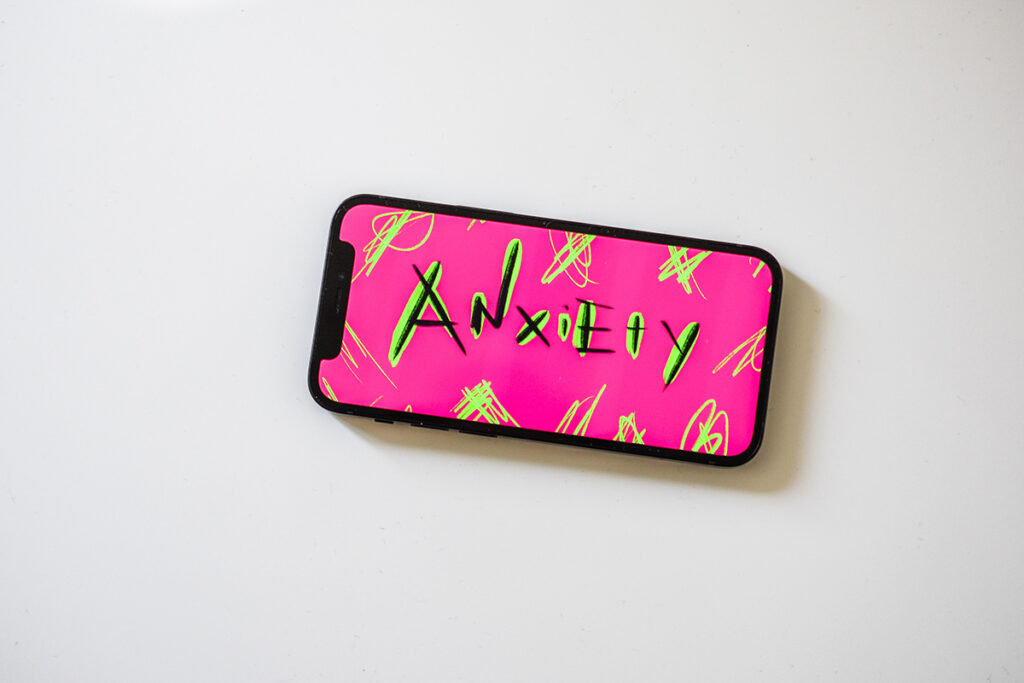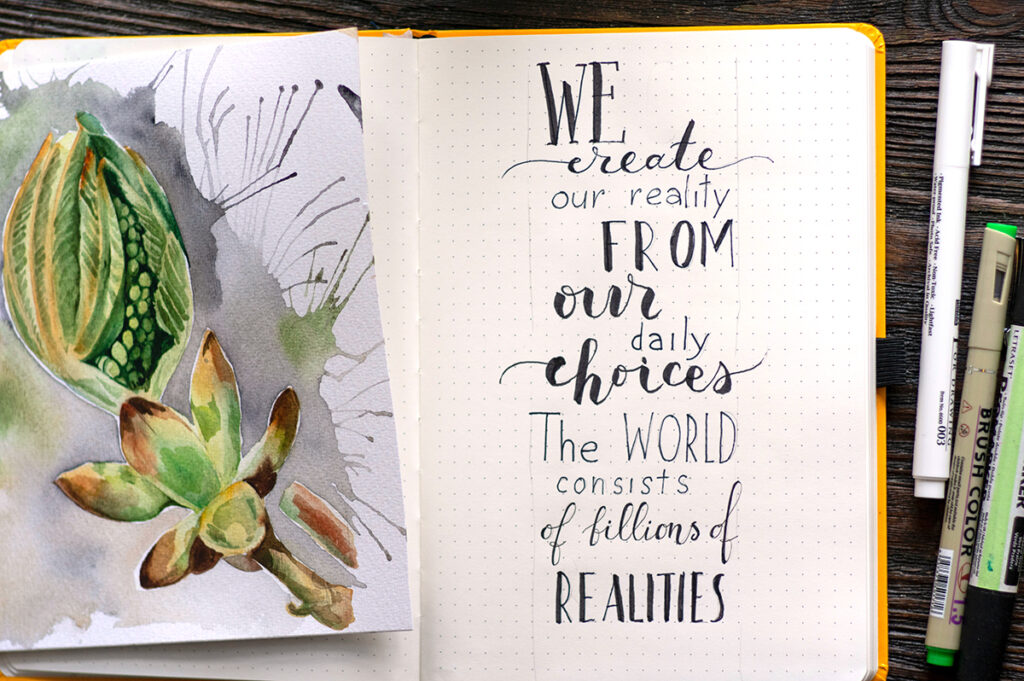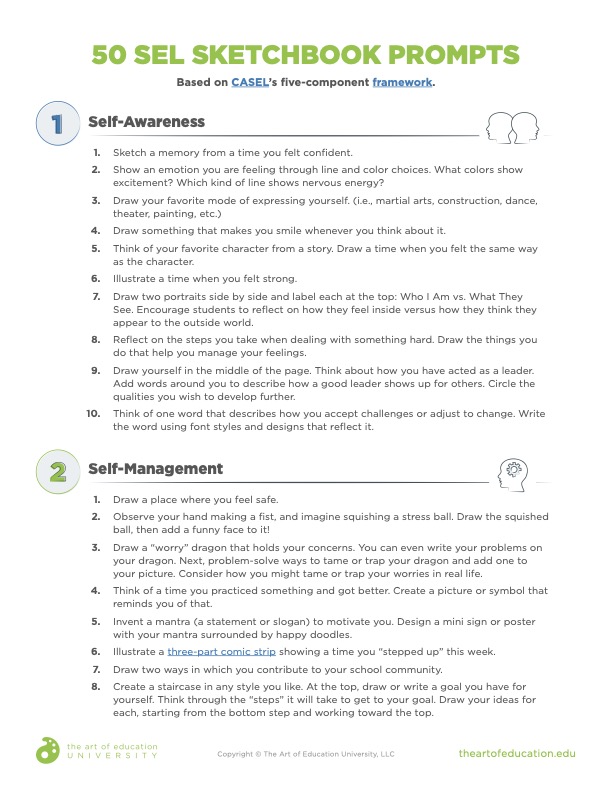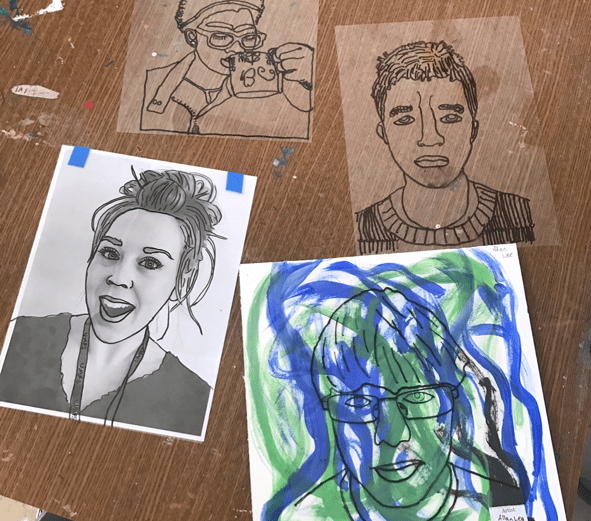Are you looking for an engaging and meaningful way to begin art class? Would you like to make sketchbooks a more intentional activity? Use social-emotional learning (SEL) sketchbook prompts to connect with students and how they are feeling. Teaching upwards of one hundred students daily can make it hard to connect emotionally with each student. But integrating sketchbook prompts with an SEL focus is one simple way to build a routine and check in with students without it being “one more thing.”

We know creating art is a way to help students express their feelings. Where social-emotional prompts shine is their ability to take it one step further and help students process their feelings and make sense of them. For many students, putting feelings into words is challenging. Therefore, students are often more willing to express themselves in their sketchbooks than verbally. Reflecting in this way can help students better understand themselves and develop greater empathy toward others. Sharing their art through these sketchbook activities also invites an adult to connect with them.
CASEL, the organization for Collaborative for Academic, Social, and Emotional Learning, has created a framework with five key components. These components are the basis for the prompts below. Use them as a guide when dreaming up your own sketchbook prompts!
The five components are:
- Self-Awareness
- Self-Management
- Social Awareness
- Relationship Skills
- Responsible Decision-Making
To make this activity as simple as possible to roll out, download the complimentary handout. This sheet includes all fifty SEL-inspired prompts. To stay organized, cross out each prompt as soon as you use it.
Download Now!
Note: The following prompts can be adapted across all grade levels. Within each component, prompts are listed from least to most complex.

1. Self-Awareness
Self-awareness is when a student can understand their “own emotions, thoughts, and values and how they influence behavior across contexts.” We want to encourage our students to explore their strengths and weaknesses, emotions, biases, and identities. We also want to cultivate students’ areas of interest and have a growth mindset.
Let’s look at ten ways to prompt our students’ thinking in this component:
- Sketch a memory from a time you felt confident.
- Show an emotion you are feeling through line and color choices. What colors show excitement? Which kind of lines shows nervous energy?
- Draw your favorite mode of expressing yourself. (i.e., martial arts, construction, dance, theatre, painting, etc.)
- Draw something that makes you smile whenever you think about it.
- Think of your favorite character from a story. Draw a time when you felt the same way as the character.
- Illustrate a time when you felt strong.
- Draw two portraits side by side and label each at the top: Who I Am vs. What They See. Encourage students to reflect on how they feel inside versus how they think they appear to the outside world.
- Reflect on the steps you take when dealing with something hard. Draw the things you do that help you manage your feelings.
- Draw yourself in the middle of the page. Think about how you have acted as a leader. Add words around you to describe how a good leader shows up for others. Circle the qualities you wish to develop further.
- Think of one word that describes how you accept challenges or adjust to change. Write the word using font styles and designs that reflect it.

2. Self-Management
Self-management is when our student artists can manage their “emotions, thoughts, and behaviors effectively in different situations and to achieve goals and aspirations.” We can introduce and model how to navigate stress, accomplish goals, plan and organize, and take the initiative.
Keep reading for ten ways to get students to reflect on this area:
- Draw a place where you feel safe.
- Observe your hand making a fist, and imagine squishing a stress ball. Draw the squished ball, then add a funny face to it!
- Draw a “worry” dragon that holds your concerns. You can even write your problems on your dragon. Next, problem-solve ways to tame or trap your dragon and add one to your picture. Consider how you might tame or trap your worries in real life.
- Think of a time you practiced something and got better. Create a picture or symbol that reminds you of that.
- Invent a mantra (a statement or slogan) to motivate you. Design a mini sign or poster with your mantra surrounded by happy doodles.
- Illustrate a three-part comic strip showing a time you “stepped up” this week.
- Draw two ways in which you contribute to your school community.
- Create a staircase in any style you like. At the top, draw or write a goal you have for yourself. Think through the “steps” it will take to get to your goal. Draw your ideas for each, starting from the bottom step and working toward the top.
- Lightly sketch a memory from a time you felt like giving up. Draw an image over the top of the sketch that represents the result from persisting instead. Press a bit harder on your pencil to make the second drawing darker.
- Draw an “obstacle” in your way. Then, add a fun image of yourself pole-vaulting over the obstacle.

3. Social Awareness
We strive for our students to “understand the perspectives of and empathize with others, including those from diverse backgrounds, cultures, and contexts.” This is a natural goal in the art room with the variety of art forms and artists across time and the globe. When focusing on this component, students investigate compassion, empathy, concern for others, and community support.
Dig in with the ten prompts below:
- Sketch a picture of you and a friend side by side. In between the both of you, list your similarities. On the outside of each person, list your differences.
- Observe a friend’s ear or look at your own in a mirror. Draw an ear on your sketchbook page as realistically as you can. Write the words “Be an Active Listener” on the same page as a reminder.
- Draw a situation when you saw something unfair happening.
- Recall a memory from when you made a new friend. Sketch the moment you first connected with them. What was happening at the time?
- Create an imaginary celebration to recognize someone’s extraordinary qualities.
- Think of a friend who is having a tough time with a problem. Invent four different products or solutions that might help your friend. These can be silly or serious. Draw your inventions!
- Draw a playground or your favorite hangout with friends. Then, think of some conflicts that happen there. What could you add to your drawing that might help resolve the disputes?
- Trace your hand and wrist on your sketchbook page to look like a tree trunk (wrist) with branches (fingers). Draw leaves coming off of each finger. On each leaf, write supportive qualities you and your friends have that help each other get through challenges.
- Identify things in society that are common but unfair (i.e., homelessness in front of mansions). Illustrate one image.
- Draw a picture that responds to the prompt, “Changing My Mind.”

4. Relationship Skills
The art room can be a bustling spot full of chatter, connection, and collaboration. In this component, students “establish and maintain healthy and supportive relationships and… effectively navigate settings with diverse individuals and groups.” Students learn to communicate, listen, negotiate, resolve conflict, and practice teamwork. They also can hone their leadership skills, help others, and stand up for others.
This valuable skill set can be discussed further with the following ten prompts:
- Use half of your sketchbook page to draw a design. Then, swap sketchbooks with a tablemate. Add your design to their page. How can your design enhance theirs?
- Draw a “teamwork” soup with your favorite “ingredients.” Your ingredients can be non-food items and be represented by symbols! For example, you might add “working together” and draw an image of a handshake. Add all of your ingredients to a bowl.
- Create an image that shows how you feel when listened to.
- Depict the qualities of a good friend.
- What are some ways to show you care about someone? Sketch a few drawings that illustrate your ideas.
- Turn and talk to a neighbor about a dilemma that is on your mind. Draw a picture of one choice the main character in your dilemma can make.
- Relationships can have red and green “flags,” or signs of negativity and positivity. Draw two flags on your page. Add an example of a negative relationship quality onto the red flag and a positive relationship quality onto the green one. Color each flag in red and green.
- Cut images from magazines that show people working together or practicing teamwork. Collage them in your sketchbook, and reflect on what it means to offer support to someone.
- Use a sticky note to flag a page in your sketchbook where you felt stuck on a drawing. Exchange sketchbooks around your table. Write two things on the sticky note: Praise their progress and one idea that offers support in completing the drawing.
- Saying “no” and standing up to pressure can be challenging, especially from your friends. Design a few comic-style speech bubbles and write different ways of saying “no” inside of them for practice. You may write, “No, thanks!” “Nope,” “That’s not for me,” or just “No.” Try out a fun font using block or bubble letters to add power to your words.

5. Responsible Decision-Making
Responsible decision-making allows our artists “to make caring and constructive choices about personal behavior and social interactions across diverse situations.” We can scaffold how to be curious, identify problems, analyze information, and make reasoned judgments. Students can consider how their choices impact others around them.
Take a look at ten prompts to spark meaningful discussion:
- Draw an image of a head with an “open mind.”
- Design the word “curious” in an interesting letter style, written vertically. Write an acrostic poem that describes how you demonstrate curiosity.
- On the bottom of your page, draw the top of a head, including the eyes. Add a thought bubble over the head and sketch out some things you think about when making a decision.
- Recall a time you helped a friend or classmate. Draw an image that represents that interaction.
- Create a drawing that shows something you are proud of yourself for doing from this past year.
- Draw a road with a fork in it. Add two road signs where it splits and label them with opposite choices (i.e., “close to home” and “far away from home”). Create imagery that shows traits of each option and consider the pros and cons of traveling down either.
- Imagine sitting down with a fortune teller and discussing a decision you must make. Draw the room’s setup with a crystal ball large enough to draw inside. Add images of potential outcomes of your decision.
- Illustrate a memory from when you made a hard decision that ended up being the right choice.
- Sketch a response showing how you would take responsibility in this scenario: Someone posts something about a friend that isn’t true on social media. What would you do? After sketching, discuss your response with a tablemate.
- Consider a famous person you admire. Draw images representing their positive impact on their community or the world.

Start your day with building empathy.
Art educators have the opportunity to cultivate a classroom environment that prioritizes social-emotional learning. Using sketchbooks and prompts can be an essential practice for many reasons. It transitions students’ minds into artmaking mode at the beginning of the class. The prompts stretch creativity and allow for more freedom, flexibility, and silliness since it’s not meant to be a finished work of art. Even if drawing is not your specialty, have no fear! Sketchbook prompts are accessible for all ages and abilities because they invite an immediate response without overthinking.
As we head into this new school year, consider creating a routine with SEL sketchbook prompts. They are a dynamic way to engage drawing skills and visually communicate with students and their inner world.
Check out some more SEL resources:
- 5 Ideas to Help Bring SEL Into Your Teaching
- The Art of SEL Podcast
- CASEL
- How to Get Middle School Students Excited About Drawing
- 50 Ideas That Support Social-Emotional Learning
What is your favorite SEL-based drawing prompt?
How do you introduce social-emotional learning in your art room consistently?
Magazine articles and podcasts are opinions of professional education contributors and do not necessarily represent the position of the Art of Education University (AOEU) or its academic offerings. Contributors use terms in the way they are most often talked about in the scope of their educational experiences.






